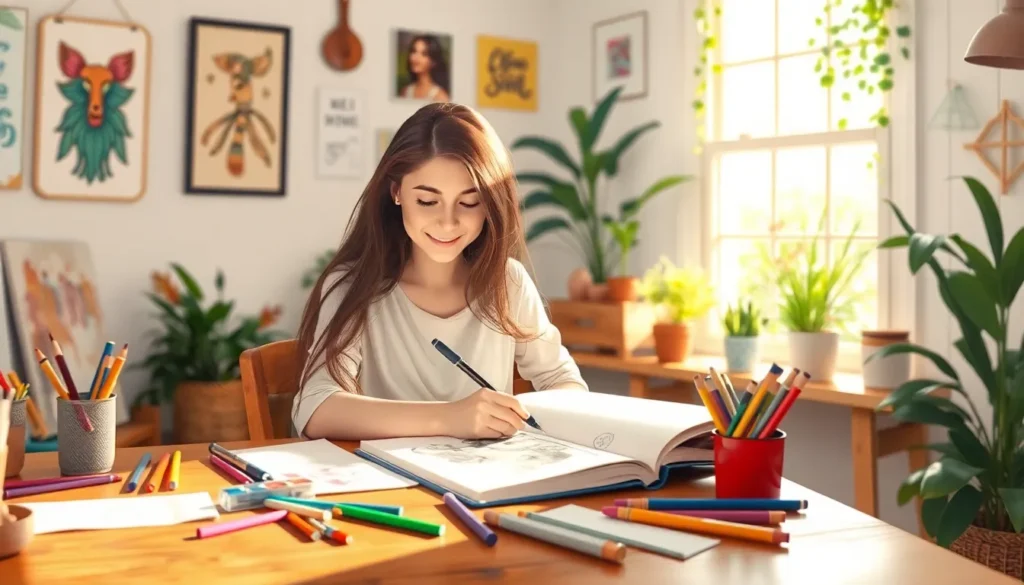In a world where stress seems to be the new normal, emotional health drawing offers a refreshing escape. It’s not just doodling; it’s a powerful tool that taps into creativity to boost mental well-being. Imagine transforming your feelings into vibrant colors and shapes, all while having a good laugh at your stick figures. Who knew therapy could be this fun?
Emotional Health Drawing
Emotional health drawing acts as a powerful tool for individuals seeking to manage stress and improve mental well-being. This form of expression allows for the manifestation of feelings through artistic creation.
Definition and Purpose
Emotional health drawing focuses on using art as a means to express and explore emotions. By drawing, individuals create visual representations of feelings, aiding in understanding and processing those emotions. This practice serves multiple purposes: it promotes relaxation, enhances self-awareness, and fosters personal growth. Engaging in drawing can evoke joy and satisfaction, transforming complex emotions into tangible art forms. Therapeutic benefits include improved mood, reduced anxiety, and heightened mindfulness.
Historical Background
The practice of using art for emotional expression dates back centuries. In many cultures, visual art has served as an important outlet for emotions. Indigenous tribes often utilized art to communicate feelings and commemorate experiences. Psychological research in the 20th century began connecting art with emotional health. Art therapy emerged as a formal discipline, recognized for its ability to facilitate healing and self-discovery. Today, emotional health drawing retains significance, reflecting its historical roots while adapting to contemporary mental health practices.
Benefits of Emotional Health Drawing

Emotional health drawing offers numerous benefits that positively impact mental well-being. Engaging in this practice not only promotes creativity but also serves as a vital tool for emotional expression.
Enhancing Self-Expression
Artistic creation provides a unique avenue for self-expression. Individuals can channel their thoughts and feelings onto paper, translating emotions into visual forms. This process fosters a deeper understanding of oneself, encouraging reflection on personal experiences. Color selection, shapes, and styles all communicate messages that words sometimes cannot. As feelings are visually represented, individuals often find clarity and insight, promoting emotional awareness and acceptance.
Reducing Stress and Anxiety
Utilizing drawing as a coping mechanism significantly reduces stress and anxiety. The act of creating art can shift focus away from daily pressures. Concentrating on the creative process induces a state of relaxation, diminishing feelings of overwhelm. Individuals frequently report improved moods after engaging in this activity. Scientific studies support these claims, showing that art activities lower cortisol levels, a hormone associated with stress. Overall, emotional health drawing serves as a practical strategy for enhancing mental wellness.
Techniques for Emotional Health Drawing
Emotional health drawing encompasses various techniques that enhance mental well-being. Two prominent methods include free drawing and guided drawing exercises.
Free Drawing and Doodling
Free drawing and doodling serve as spontaneous expressions of emotions. Artists often allow their hands to move freely across the page, creating shapes and forms without restrictions. This technique encourages creativity and promotes relaxation, letting individuals explore feelings without judgment. Participants may find that doodling helps them focus, often resulting in clarity regarding their emotional state. Numerous studies highlight that engaging in free drawing can reduce anxiety and elevate mood, making it an accessible approach for mental health maintenance.
Guided Drawing Exercises
Guided drawing exercises provide structure to emotional health drawing. Instructors or workbooks often outline specific themes, prompting individuals to reflect on their feelings while drawing. This practice can involve drawing prompts, such as illustrating personal experiences or visualizing emotions. Following these prompts can deepen self-awareness, making individuals more in tune with their feelings. Research indicates that guided exercises enhance the therapeutic effects of drawing. They can foster meaningful expression while reinforcing emotional resilience, benefiting mental well-being.
Incorporating Emotional Health Drawing in Daily Life
Incorporating emotional health drawing into daily routines enhances mental well-being. This practice encourages individuals to express emotions through art, making it a valuable tool for stress management.
Tips for Practicing Regularly
Starting small ensures consistency. Setting aside 10 to 15 minutes daily for drawing fosters a habit. Keeping materials readily accessible can also increase the likelihood of engaging in this practice. Exploring various styles, such as doodling or abstract drawing, promotes creativity. Joining a community or finding a drawing partner can provide support, making it easier to stay committed. Additionally, setting specific drawing goals, like creating a weekly artwork, helps maintain motivation.
Creating a Supportive Environment
Creating a comfortable space enhances the drawing experience. Surrounding oneself with inspiring art or calming elements, such as plants, fosters creativity. Choosing a quiet area minimizes distractions, allowing for deeper emotional exploration. Establishing specific times for drawing can turn it into a cherished ritual. Inviting positive affirmations or quotes into the space reinforces emotional health. Removing negative influences, such as clutter or stressors, makes it easier to focus on the drawing process.
Conclusion
Emotional health drawing offers a unique approach to managing stress and enhancing overall well-being. By transforming emotions into visual art, individuals can gain clarity and foster self-awareness. This practice not only serves as a creative outlet but also promotes relaxation and joy.
Incorporating drawing into daily routines can create a meaningful ritual that supports emotional health. Whether through free drawing or guided exercises, the benefits are clear. With a commitment to regular practice, anyone can harness the power of art to navigate their emotional landscape and improve their mental wellness.

